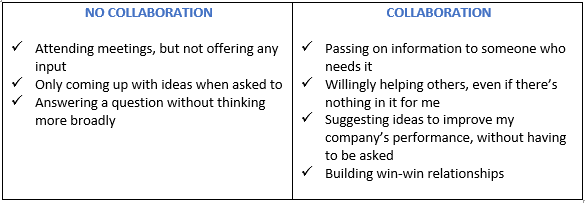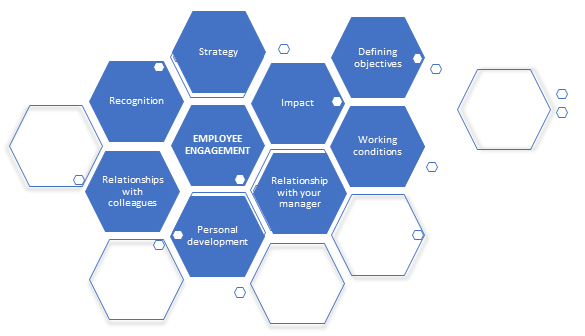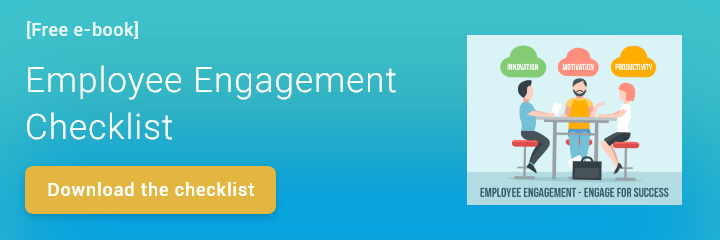You have no doubt already noticed that boosting employee engagement can help reduce staff turnover and increase customer satisfaction. But did you know that strong employee engagement can also make you money? Companies with high levels of employee engagement generate 20% more net profit.
Let’s delve deeper into this figure and learn how good employee engagement can help boost your company’s performance, turnover and profitability.
- Make better decisions with collective intelligence
If your employees are engaged, it will be easier for them to work together and collaborate. Remember the old adage “united we stand, divided we fall”? It’s true: we think better and more effectively when we work as a team. Collaborative working allows your employees to bounce ideas, share their knowledge and come up with better solutions.
Let’s go a step further: do you really understand the difference between cooperative and collaborative working?
- With cooperative working, one person completes a task, then passes their work on to a second person, who in turn does their own task, before passing it on to a third person.
- In a collaborative working setup, the 3 people constantly interact with one another and move forward together to get the job done. They make faster progress, learn more and deliver better results. This is what’s known as collective intelligence. Put simply, a solution developed by 4 people will be better informed than a solution developed by just one person. It will draw on more perspectives and be easier to adapt.
This distinction may seem subtle, but in fact it’s not and the results prove it. Here are just a few examples of the difference between collaborative and cooperative working:
I do not collaborate when:
- I attend a meeting, but do not have any input.
- I come up with ideas only because I’ve been asked to.
- I answer a question put to me, without taking any interest in the person asking.
I do collaborate when:
- I give someone some information because I think they need that information.
- I devote some of my time to helping others, even if doing so doesn’t help me achieve my own goals.
- I suggest ideas to improve my company’s performance without having to be asked.
- I try to build win-win relationships.

- Listen to and understand your teams
There is much less risk of an engaged employee leaving their company than one who is disengaged and demotivated. Obvious though this may seem, we don’t always put in place the measures needed to ensure we are doing everything to engage our employees and therefore retain talent. In reality, engagement is made up of a dozen complex and diverse factors. Assessing these can be tricky. Just ask yourself this question: would you have any way of knowing whether each of your employees finds their work meaningful at a given moment? Could you answer this same question in a week’s time, given any developments that may have taken place in your company in the meantime? It is in fact extremely difficult to gather such a large amount of information working alone and without using the right tools. A pulse survey can help you with this, by giving you an insight into how engaged each of your employees is on an ongoing basis, allowing you to respond to their expectations and in doing so retain talent.

Be sure to choose a pulse survey that will enable you to keep track of how your employees are feeling on an ongoing basis.
- Surveys should be sent out very regularly and no less than once per month. Your pulse survey should be done in real time to ensure that you tap into any changes your company is going through.
- All your employees must be surveyed. Don’t leave anyone out.
- Surveys should be accessible from any internet-connected device (e.g. a computer or smartphone).
- Answers must be anonymised to ensure the feedback you get is honest.
- Take care to ensure that your employees’ answers aren’t influenced by what the survey looks like, such as the use of colours or emoticons. For example, don’t associate negative responses with a sad face or the colour red, as this could bias the respondent’s opinion.
Top tip: Use a Likert-scale format. Give respondents the option to express how much they agree or disagree with a particular statement on a scale of 0 to 5, from “Strongly disagree” to “Strongly agree”. This scale is used in social psychology and is a way of getting much more accurate answers to questions, as well as a better understanding of your employees’ expectations and needs.
- Attract top talent
In a company with high levels of engagement, 80% of employees would recommend their employer, compared with just 13% in one where engagement is low. In other words, if your employees are sufficiently engaged, they will talk about your company. When they talk about your company, it boosts your employer brand, meaning you can attract more talent and improve your results.
Engagement = Better employer brand = Attracts talent
- Boost customer satisfaction
According to the principle that “if you look after your staff, they will look after your customers”, the quality of the relationship between your company and its employees is key to maintaining good customer relations. If your teams have a positive employee experience and feel that their quality of work life is better than it would be elsewhere, they will want to pass on their sense of satisfaction to your customers and make them feel satisfied in turn. If your customers feel satisfied, they will come back and buy your products again, renew their subscription or recommend you to their colleagues and contacts.




